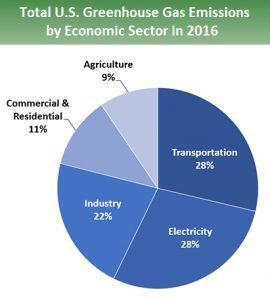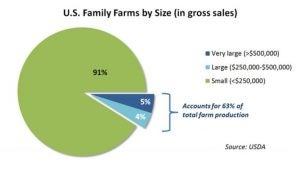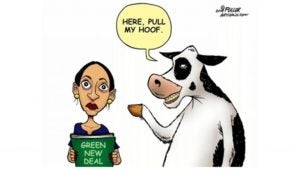The Green New Deal called on the U.S. to take a leading role in reducing emissions. Let’s examine the resolution’s ag initiatives and how farmers are already well ahead of this curve.
Editor’s note: The Senate has blocked legislation to advance the Green New Deal resolution on a procedural vote, with relatively few lawmakers signaling endorsement of the plan.
As you’ve probably heard in the news, Congresswoman Alexandria Ocasio-Cortez (D-N.Y.) had presented a proposal to Congress called the Green New Deal that addresses how the U.S. can achieve net-zero greenhouse emissions in 10 years, in addition to tackling inequality and wage reform. This deal, brashly named after Roosevelt’s New Deal to help the U.S. economy recover from the Great Depression, puts forth a lot of idealistic proposals but without much specificity, strategic planning and research. Since we’re a blog about food and agriculture, let’s focus on the initiatives affecting farmers and our food supply.
Ag Initiatives
The bulk of this resolution concentrates on reducing greenhouse gas emissions, a concept not new to the ag industry. And while ag contributes the smallest amount of total U.S. emissions among the EPA’s designated sectors, the resolution focuses on three initiatives for agriculture to become more environmentally friendly:
- Supporting family farming
- Investing in sustainable farming and land use practices that increase soil health
- Building a more sustainable food system that ensures universal access to healthy food

Though these initiatives may sound original, those in ag have been implementing these goals for years now and without government intervention! Farmers regularly collaborate with cross sections of both corporations and organizations to formalize efforts on sustainability and productivity. Not one successful farmer or rancher acts independently — they know the best way to take care of their land while feeding a hungry nation is to work interdependently across sectors to achieve these goals.

Supporting Family Farming
The USDA states that 96 percent of the 2.2 million U.S. farms are family-owned, and this number is on the rise. Furthermore, these family-operated farms account for 78 percent of total farm production in the U.S. We are already a nation of family farms!

Additionally, consumers are shifting towards a preference for locally-grown produce and meat. While being a small farmer today brings little financial security, those who are innovative and creative continue to add value to our food system, as well as make profits to stay in business.
Investing in sustainable farming and land use practices that increase soil health
Contrary to how they are depicted in most media outlets, farmers and ranchers are the most vested stewards of the land.
Take, for example, the now-viral response to The Green New Deal from Kansas rancher, Brandi Buzzard Frobose:
“As a rancher, I can tell you that we take the quality of the great outdoors very seriously — air, soil and water quality are all of utmost importance to us here because, well we are the ones living here in the sticks. Which is why our segment of agriculture actively works to reduce our impact on the environment every. single. day.”
To help food producers and the millions of other concerned American citizens make more informed decisions on issues like climate change, The National Cattlemen’s Beef Association (NCBA) released a Cost/Benefit Principles for Climate-Change Policy.
Colin Woodall, NCBA Senior Vice-President, Government Affairs told Northern Ag Network:
“These are very straightforward questions that any concerned citizen or reporter should be asking anyone who proposes new climate-change policy. What specifically are you proposing, how much will it cost, how much will it affect global temperatures down the road, and how did you arrive at those numbers? Seems like anyone who is proposing billions or trillions of dollars’ worth of policy changes should be happy to answer those questions. Yet for some reason, few currently are.”
According to Woodall, U.S. beef producers have already made a great deal of progress on environmental issues like climate change, such as producing the same amount of beef with 33 percent fewer cattle, compared to 1977.
Woodall also pointed out that beef producers in the U.S. now have one of the lowest carbon footprints compared to many of their worldwide counterparts, now producing only 2 percent of all carbon emissions in the U.S.
As for the quality of soil, many farmers employ best practices to increase soil health, as they know first-hand how essential healthy soil is for producing the best fruits, vegetables, and livestock. These farmers, much like the McMenamins at Versailles Farms, utilize precision technologies like soil moisture sensors, irrigation sensors, and, when necessary, synthetic inputs based on detailed soil analyses. Farmers and ranchers consider all these factors to operate the most productive farms possible while being stewards of the land.
Building a more sustainable food system that ensures universal access to healthy food
Not much argument here about a right to food — we completely agree. However, this system has been in place for quite some time now. In fact, it is because of the U.S. food supply system and the SNAP (food stamp) program that everyone currently has access to clean, healthy, affordable food.
We also understand that there’s always room for improvement, but creating efficiencies in this intricate web of food producers, suppliers, and distributors will take a very detailed plan — something far more specific than the gross generalities outlined in The Green New Deal.
A strategic plan for something of this magnitude requires government, corporate and organizational compliance and oversight.
Technological Feasibility and Consumer Acceptance
We as consumers are eating more than ever, now clocking in over 3,600 calories per day. Farmers and ranchers are being asked to produce more food on less land using less water, fewer pesticides, and less energy.
Farmers are adopting precision farming technologies to help them reduce their water usage, reduce emissions, use less energy, increase crop yield, reduce pesticides, and reduce fertilizers. Genetic engineering, like GMOs and CRISPR, can also help create a more sustainable food system, but consumers and red tape often stall technological innovations.
The resolution calls on achieving net-zero emissions in 10 years in whatever means is technologically feasible. Roadblocks and propaganda create a sentiment that has such advances either stuck in a prolonged approval process or generally distrusted among consumers.
Take the “Non-GMO Project Verified” label, which not only vilifies GMOs, but also encourages companies with food products that don’t even have a GMO counterpart (like wheat, avocadoes, berries, even water!) to buy the rights to use its label, stoking fears among consumers to only purchase non-GMO products.
Counterproductive organizations and lack of government oversight in their practices make technological advances like genetic engineering a very formidable challenge in consumer perception and adoption.
What Does This Mean for Farmers?
Because of the Green New Deal’s lack of clarity, many in the sector have become fearful that further plans will place a cap on livestock, dairy production, and other industry-shaking restrictions.
Others think it may just be a matter of perspective. Popular Science sheds a positive light on the proposal, writing that perhaps it has less to do with reducing fossil fuels (and the farting cow fiasco — which, if we really want to be specific, should be corrected to cow burps) and more to do with the “net-zero carbon” aspect of carbon farming, planting more trees, and revitalizing our soils.

What’s probably the most disheartening about the Green New Deal is that these green initiatives are not considering developments already taking place in our food supply using fewer resources. We are improving nutrition by advancing supply chains while reducing food waste. We’re also reducing environmental impacts by breeding more productive plants and animals and investing in biotechnology. We hope that as this proposal develops, those behind the Deal take the time to learn more about current initiatives.
THE BOTTOM LINE
The Green New Deal would benefit from specific, science-backed ways to reduce emissions in the ag industry while currently meeting consumers’ ever-growing food demands. The talk boxes behind the initiatives may want to meet with farmers and ranchers feeding the needs of a growing population while using fewer resources to better understand the industry before creating lofty guidelines that are out of touch with reality.
Dirt-to-Dinner strives to help the public better understand how food is grown and processed, and why this is important. D2D also helps investigate the future of food and our global food system and explains how this system can be sustainable.



